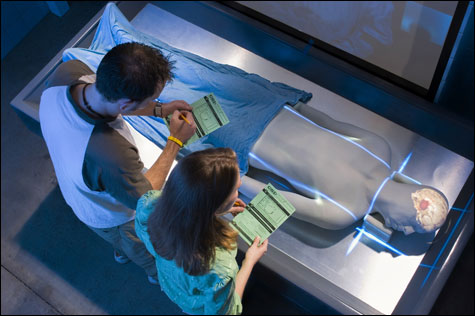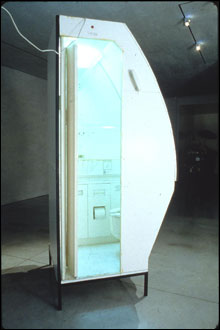
GIL GRISSOM SAYS: “Let the evidence guide you.”
|
|
“CSI: The Experience” Museum Of Science | Science Park, Boston | Through January 1 | “Tom
Sachs: Logjam” Rose Art Museum, Brandeis, 415 South St, Waltham | Through December 16
|
“Crime scenes are puzzles,” crime-scene investigator Gil Grissom solemnly explains in a video that opens the exhibit “CSI: The Experience” at Boston’s Museum of Science. “Notice everything. Document everything. Let the evidence guide you. Remember the dead can’t speak for themselves.”
I dutifully scribbled down this serious wisdom and then headed into the interactive exhibition. “CSI: The Experience” immerses visitors in the world of CSI: Crime Scene Investigation, which premiered in 2000, and its two spinoffs, which routinely rank among the top 20 most-watched shows on television. So you surely know that they feature the sleuthing of fictional police forensic scientists, among them Mr. Grissom (played by William Petersen).
The TV show taps into our infatuation with crime, gore and mysteries, as well as our craving for justice and punishment. “CSI: The Experience,” which was developed by the Fort Worth Museum of Science with support from the CBS corporation and CSI television folks, aims to promote “critical thinking skills” and teach us about forensic science, “where science meets the law.” But it’s really about the thrill of playing a TV crimefighter, with the requisite cheesy quips, ludicrously convoluted trails of clues, and stock characters: the ne’er-do-well twin brother, the disgruntled ex-wife, the runaway turned aspiring actress, the jealous gal pal, the loyal dog. It’s campy fun, like playing Clue, but with more digital gore. It flatters our couch-potato conviction that, given the chance, we could sniff out clues as diligently as any real-life Sherlock.
Choose one of three simulated crime scenes for study. A House Collided has a car crashed into a living room with a dead dude slumped behind the wheel. Who Got Served? presents a woman lying dead and run over in an alley behind a motel. No Bones About It offers a skeleton with a suspicious hole in its forehead lying in a shallow grave in a desert.
Touch-screen computers, microscopes, and hands-on comparison charts help you analyze fingerprints, blood-spatter patterns, blood-alcohol levels, blowflies buzzing around a corpse, bullets, hair, seeds, dental records, and DNA. In specially shot videos, characters from the TV show explain stuff. Special effects make it appear that corpses are being sliced and diced during autopsies — with cool grisly squishy sound effects.

LAV A2: Sachs’s work is a shrine to the DIY
ethos.
|
Throughout, Gil Grissom’s words echoed in my head: “Let the evidence guide you.” It occurred to me that one piece of important evidence, or at least testimony, was missing: the doubts DNA-based exonerations have raised about the accuracy of many of the forensic techniques here. And that led to another realization: “CSI: The Experience,” like a B-movie, is best if you don’t think too hard about it.
New York sculptor Tom Sachs’s “Logjam,” organized by the Des Moines Art Center and now at Brandeis’s Rose Art Museum, is a shrine to the DIY ethos. In past exhibits, Sachs has razzed corporate and government power by building a model Nazi death camp from Prada boxes, a “Chanel” guillotine, the US presidential seal, McDonald’s stock certificates, and a prison cell door made from swiped wooden police barricades. Here, his subjects are devoted to the essential nature of his craft — a combo of reverse engineering, crackpot inventing, hobby modeling, woodshop tinkering, and car customizing.
The best thing here is Lav A2 (1999), a lifesize (apparently) working replica of an airliner bathroom built from foamcore, glue, and a Craftsman portable wet/dry vac. Sachs nails all the details, down to the kleenex dispenser and the light-up “Return to seat” sign. It’s an ingenious, obsessive joke that’s taken on dark undertones now that we live in the era of airplane anxiety.
Nutsy’s Tableau (2002-2003) is a giant, elaborately constructed racetrack for remote-control cars, complete with drawbridge, speed gun, a tunnel through a refrigerator (for beer, naturally), Rube Goldberg mazes, a ring of fire, and a mini foamcore gas station. It’s like the coolest basement hobby project ever — if you can get past the bad-asser-than-thou shop-geek attitude.
The exhibit is rounded out by an old office desk that Sachs converted into a stylish saw table, a custom drill press, specialized tool boxes, and prototypes for a sink and toilet. They’re neat, but they lack the conceptual zing of his best stuff.